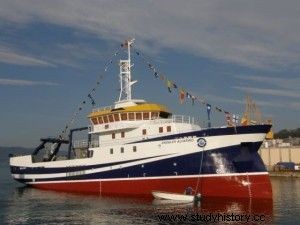
The Spanish government suspected that it could be the Fragata of Our Lady of Mercedes sunk in 1804 by the British crown. Thus, they fought to recover Spanish heritage, a battle against looting and the antiques market. The litigation held from 2007 to 2012 between Odyssey and Spain for the return of the treasure of the Fragata Mercedes, today continues to arouse interest and many unanswered questions, aspects that we will deal with in issue #3 of Archaeology and History:The treasure of the Mercedes .
The treasure hunting company hid the archaeological material extracted and the location of the sunken wreck, claiming that it was not the frigate but a British ship sunk in the North Atlantic. The Supreme Court of the United States, after agreeing with the Spanish government, rejected the appeal filed by Odyssey and ordered the return of the extracted coins to Spain.

And we believed that as soon as the material was delivered to the Spanish researchers would have solved everything… but no! After three years, it has been in 2015 when they have wondered if everything declared by Odyssey was accurate, both the location and the recorded material. The point of this matter is that it is not known with certainty if Gregory Stemm (founder of Odyssey) has told the whole truth about the wreck, or if he has delivered all the looted material, since in the company's own documentaries cannons and in the return have not been included or mentioned.
The General Director of Fine Arts and Cultural Assets, Miguel Ángel Recio, confirmed that the work carried out by Odyssey would be inspected to prevent his testimony from being the last to know the truth about the site and disseminate scientific research, not that of looters. Relying on archaeological methodology, they would verify if they told the truth regarding the location of the wreck, whether the material recorded in the company's videos, such as the cannons, are still there or if they have been hidden, and they would study the rest of the excavation with the archaeological vision with the one that should have been analyzed.
For this reason, the underwater investigation of the wreck was demanded, and of course, there were even more problems... UNESCO wanted to be part of the investigation as it was of international interest, proposing the use of a French ship. The Spanish Government and investigators shouted to the skies alleging that our scientific means were perfectly capable of carrying out the investigation.
Finally, without the help of UNESCO, it was determined that the project would be carried out this summer between August 18 and 24, led by Iván Negueruela, from the Arqua Museum in Cartagena together with the collaboration of Eduardo Baldegueñas, Director of the Spanish Institute of Oceanography (IEO); a collaborator from the Naval Museum and a film crew.

In this way, the oceanographic vessel Ángeles Alvariño set sail on August 17 towards the coast of Cádiz with 13 scientists and 14 crew members on board and investigated 30 miles from the Portuguese coast of Faro, which is where the treasure hunting company claims to have discovered the wreck. The ROV Liropus 2000 device was in charge of receiving, analyzing and transferring the information through HD images to the oceanographic vessel to estimate the damage caused to the Mercedes Frigate and thus assess its state of conservation.
We will be awaiting the results obtained in this unique and highly relevant underwater archeology project, which could reveal transcendental information for Spanish colonial research in America. In addition, it is about the recovery of the historical memory that condemned the Fragata Nuestra Señora de las Mercedes to the depths of the Atlantic Ocean and that as a tribute, it is already planned to place a commemorative plaque to the fallen of that battle in the submarine site itself. .
The ocean that hosts great discoveries and many are those who take advantage of it…
